1. 读取图片
import matplotlib.pyplot as plt import tensorflow as tf import numpy as np image_raw_data = tf.gfile.FastGFile('./datasets/cat.png','rb').read() with tf.Session() as sess: image_data = tf.image.decode_png(image_raw_data) # 输出解码之后的三维矩阵。 print(image_data.eval()) image_data.set_shape([1797, 2673, 3]) print(image_data.get_shape() )
输出结果:
[[[ 0 0 0 255]
[ 0 0 0 255]
[ 0 0 0 255]
...
[ 0 0 0 255]
[ 0 0 0 255]
[ 0 0 0 255]]
[[ 0 0 0 255]
[ 31 31 26 255]
[ 39 39 34 255]
...
[ 20 30 3 255]
[ 21 30 5 255]
[ 21 30 8 255]]
[[ 0 0 0 255]
[131 130 111 255]
[164 162 139 255]
...
[ 90 126 18 255]
[ 93 130 19 255]
[ 93 129 34 255]]
...
[[ 0 0 0 255]
[162 160 143 255]
[203 196 177 255]
...
[181 145 170 255]
[137 98 133 255]
[116 76 111 255]]
[[ 0 0 0 255]
[164 160 143 255]
[204 197 178 255]
...
[ 95 62 70 255]
[ 91 67 69 255]
[119 100 94 255]]
[[ 0 0 0 255]
[131 127 114 255]
[163 159 143 255]
...
[ 89 67 45 255]
[ 86 66 45 255]
[ 86 66 43 255]]]
(1797, 2673, 3) #shape
2. 打印图片
with tf.Session() as sess: plt.imshow(image_data.eval()) plt.show()
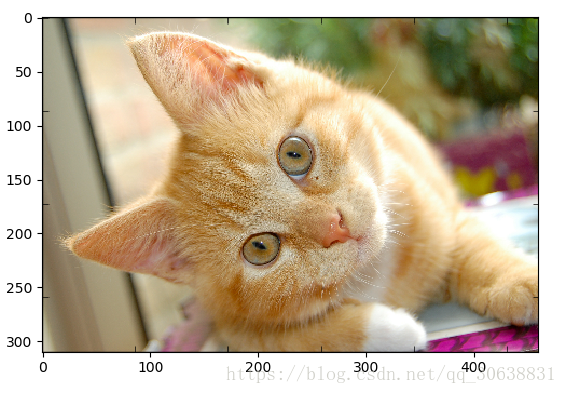
3. 重新调整图片大小
import matplotlib.pyplot as plt import tensorflow as tf import numpy as np image_raw_data = tf.gfile.FastGFile('./datasets/cat.png','rb').read() with tf.Session() as sess: image_data = tf.image.decode_png(image_raw_data) ''' resize_images第三个参数 0 双线性插值法 1 最近邻居法 2 双三次插值法 3 面积插值法 ''' resized = tf.image.resize_images(image_data, [300, 300], method=0) # TensorFlow的函数处理图片后存储的数据是float32格式的,需要转换成uint8才能正确打印图片。 print("Digital type: ", resized.dtype) cat = np.asarray(resized.eval(), dtype='uint8') # tf.image.convert_image_dtype(rgb_image, tf.float32) plt.imshow(cat) plt.show()


4. 裁剪和填充图片
import matplotlib.pyplot as plt import tensorflow as tf import numpy as np image_raw_data = tf.gfile.FastGFile('./datasets/cat.png','rb').read() with tf.Session() as sess: image_data = tf.image.decode_png(image_raw_data) croped = tf.image.resize_image_with_crop_or_pad(image_data, 200, 200) padded = tf.image.resize_image_with_crop_or_pad(image_data, 3000, 3000) plt.imshow(croped.eval()) plt.show() plt.imshow(padded.eval()) plt.show()
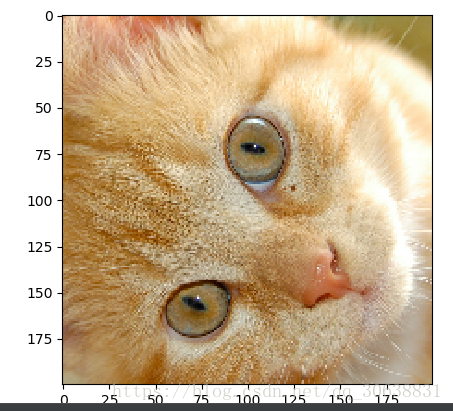
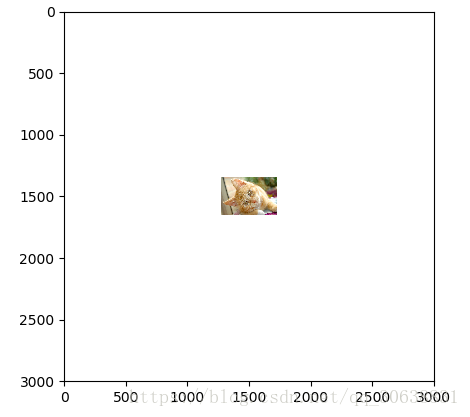
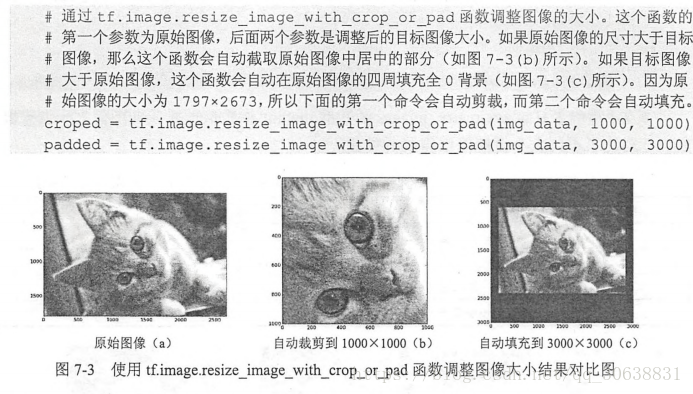
6. 翻转图片
import matplotlib.pyplot as plt import tensorflow as tf import numpy as np image_raw_data = tf.gfile.FastGFile('./datasets/cat.png','rb').read() with tf.Session() as sess: image_data = tf.image.decode_png(image_raw_data) # 上下翻转 # flipped1 = tf.image.flip_up_down(img_data) # 左右翻转 # flipped2 = tf.image.flip_left_right(img_data) # 对角线翻转 transposed = tf.image.transpose_image(image_data) plt.imshow(transposed.eval()) plt.show() # 以一定概率上下翻转图片。 # flipped = tf.image.random_flip_up_down(img_data) # 以一定概率左右翻转图片。 # flipped = tf.image.random_flip_left_right(img_data)

7. 图片色彩调整
import matplotlib.pyplot as plt import tensorflow as tf import numpy as np image_raw_data = tf.gfile.FastGFile('./datasets/cat.png','rb').read() with tf.Session() as sess: img_data = tf.image.decode_png(image_raw_data) # 将图片的亮度-0.5。 # adjusted = tf.image.adjust_brightness(img_data, -0.5) # 将图片的亮度-0.5 # adjusted = tf.image.adjust_brightness(img_data, 0.5) # 在[-max_delta, max_delta)的范围随机调整图片的亮度。 adjusted = tf.image.random_brightness(img_data, max_delta=0.5) # 将图片的对比度-5 # adjusted = tf.image.adjust_contrast(img_data, -5) # 将图片的对比度+5 # adjusted = tf.image.adjust_contrast(img_data, 5) # 在[lower, upper]的范围随机调整图的对比度。 # adjusted = tf.image.random_contrast(img_data, lower, upper) plt.imshow(adjusted.eval()) plt.show()
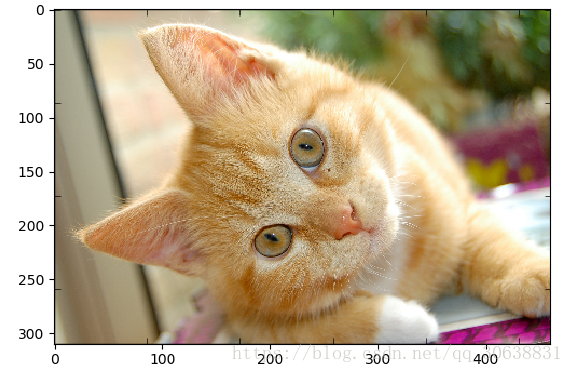
8. 添加色相和饱和度
import matplotlib.pyplot as plt import tensorflow as tf import numpy as np image_raw_data = tf.gfile.FastGFile('./datasets/timg.jpg','rb').read() with tf.Session() as sess: img_data = tf.image.decode_jpeg(image_raw_data) print(img_data.get_shape()) #img_data.set_shape([1797, 2673, 3]) #adjusted = tf.image.adjust_hue(img_data, 0.1) adjusted = tf.image.adjust_hue(img_data, 0.3) #djusted = tf.image.adjust_hue(img_data, 0.6) # adjusted = tf.image.adjust_hue(img_data, 0.9) # 在[-max_delta, max_delta]的范围随机调整图片的色相。max_delta的取值在[0, 0.5]之间。 # adjusted = tf.image.random_hue(image, max_delta) # 将图片的饱和度-5。 # adjusted = tf.image.adjust_saturation(img_data, -5) # 将图片的饱和度+5。 # adjusted = tf.image.adjust_saturation(img_data, 5) # 在[lower, upper]的范围随机调整图的饱和度。 # adjusted = tf.image.random_saturation(img_data, 1, 2) # 将代表一张图片的三维矩阵中的数字均值变为0,方差变为1。 #adjusted = tf.image.per_image_whitening(img_data) plt.imshow(adjusted.eval()) plt.show()
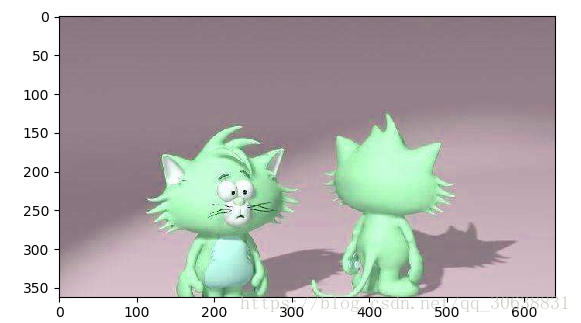
9. 添加标注框并裁减。
最后
以上就是坚强魔镜最近收集整理的关于TensorFlow图像处理函数的全部内容,更多相关TensorFlow图像处理函数内容请搜索靠谱客的其他文章。








发表评论 取消回复